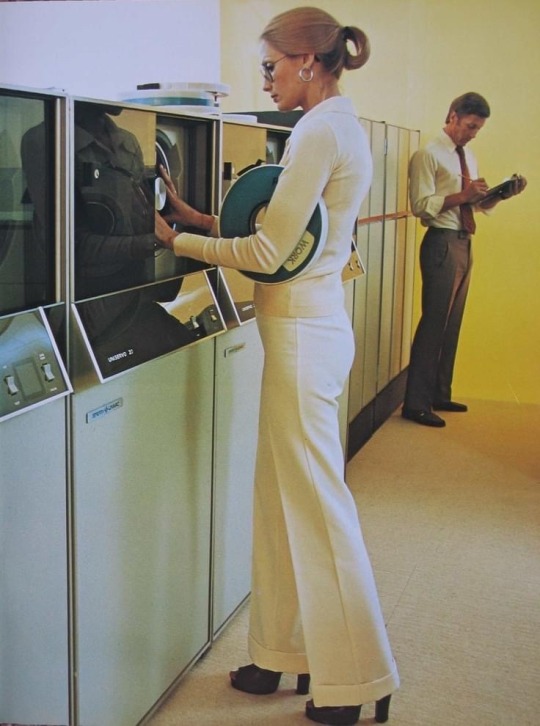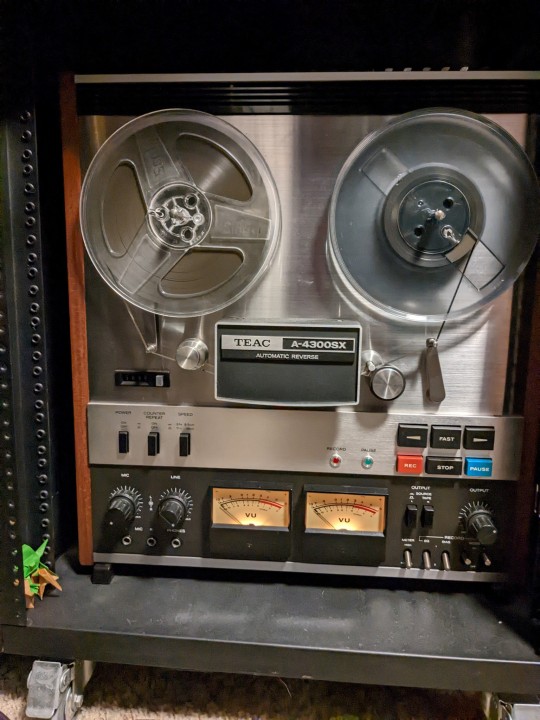#magnetic tape
Text

Working in a datacenter in the 70s
#retro#70s#1970s#fashion#datacenter#retrocomputer#70s fashion#vogue#mainframe#magnetic tape#computer operator#retro computers#big iron#women in stem#women in tech
670 notes
·
View notes
Text

Reels of data tape at Los Angeles County’s computer center in Downey, California, 1976. Photo by Cal Montney.
988 notes
·
View notes
Text
its so funny when people act like the limewire era was the first time people pirated music, and that 99 cents a song was agreed to by everyone in the world. i guarantee you beyond a shadow of a doubt your parents at the very least KNEW somebody who recorded songs from the radio on to a cassette tape. this was considered the most normal thing in the world to do: you like the song, you record the song, you listen to it again later.
#magnetic tape#as a kid in the early 00s#my own dad used to go to the library#borrow a jazz CD#and record it to tape#he did this nearly SIXTY TIMES#and i can tell that because#there are SIXTY tapes in a case next to me#nearly all of which are unhelpfully labeled 'JAZ'
94 notes
·
View notes
Photo

Caroline K of Nocturnal Emissions splicing magnetic tape in her studio in Carlton Mansions, Brixton, 1986
406 notes
·
View notes
Photo

‘For your tape recorder - Kodavox High Fidelity‘
Advertisement for Kodak’s Kodavox high fidelity recording tape (c. 1960). Artwork by Lantelme.
#vintage advertisement#1960s#kodak#kodavox#Lantelme#tape recorder#magnetic tape#recording tape#tape reel#french#france
97 notes
·
View notes
Text

There was a home video tape format called Video 2000 (V2000), that was released in late-1970s and discontinued in late-1980s. It was mostly owned by Philips. These kinds of tapes can literally record video content on both sides in the similar way as audio cassettes.
The format itself, had minor success in Europe, just like what Sony's Betamax (Beta) had its same level of success in the US. However, both of them lost to VHS. But, Video 2000 is obscure and unpopular in North America.
The image is from Wikimedia Commons.
#video 2000#v2000#philips#video tape#magnetic tape#tape media#physical media#old tech#old technology#vintage technology#vintage tech#retro tech#analog media
13 notes
·
View notes
Text
A thrift store find that I didn't buy, because it's more esoteric than even I could manage to use, and I'm trying not to accumulate large useless things:


This is a Muntz Stereo-Pak player. This particular model is the home version; Stereo-Pak was the first prerecorded magnetic tape format for car audio, released in 1962, and a precursor to the 8-track tape. Music came in cartridges, inside of which would be a long loop of 4-track tape; on the tape would be two streams of music, with left and right channels for each.
You're meant to slide your tape cartridge up against the magnetic read head inside, guided by the brass grooves on the top. I haven't read anywhere that there were different sizes of cartridges, but the different lines on the face and the lack of hard guides suggests that to me. Once it's in place, one of the levers on the right flips a rubber pinch roller up to pull the tape past the head, playing back the stereo tracks. The other lever is a switch that pops the tape head between its upper and lower position, so you change it to change which tracks are playing.
(There was prerecorded audio for cars before then, because some loons decided to install phonographs. Chrysler's "Highway Hi-Fi" (1956-'59), for example, played special 16⅔ RPM records. For obvious reasons, there were problems with skipping, and the higher-pressure tone arms that tried to alleviate that wore the records out faster.)
The format and the players were developed for Earl "Madman" Muntz, an LA businessman known for an eccentric public persona and oddball marketing campaigns (inspiring such successors as "Go See Cal" Worthington and the "Crazy Eddie" electronics chain in New York). He started out with used car dealerships but his real love was electronics; he started Muntz TV in 1947, and was the first to sell a TV set for less than $100, new. He was a self-taught electrical engineer, and got his TVs to be so cheap through a technique still today called Muntzing. He'd decided that most engineers were designing conservatively, building redundancies and safety margins into their devices, so when his employees presented him with a prototype, he'd go at it with a pair of wire cutters. He'd start just snipping parts out until the thing stopped working — and then tell the engineer, "Well, I guess you have to put that last part back in."
(His TVs were fine in the cities, where big stations had strong signals, but worked quite poorly out in areas where the signals were weak; the parts he'd remove were the ones that boosted performance out there. This wasn't by accident, though; his target market was the city dweller with limited funds, and Muntz was content to let RCA and Zenith and such have the high performance market.)
Anyway, Muntz TV went bankrupt in 1959 after various hardships, and reorganized without "Madman" at the helm. (You may be able to make out the note under the logo on the player that Muntz Stereo is not affiliated with Muntz TV.). Muntz himself was still managing to do well with cars and consumer electronics, so he decided to combine the two with the Stereo-Pak. He had a great deal of success for a while with it, but it was later outcompeted by the 8-track player (which won economically because it used less tape to store the music and had a simpler mechanism, and became hugely popular once Ford started offering the players preinstalled). Muntz ran the company that put commercial recordings on the tapes, and that led to probably his biggest unforseen financial problem with these. See, there'd be the new big radio hit, the new big famous musical group, and he'd rush their album out to all the dealers — and when the new hotness inevitably became yesterday's news, the dealers would send the unsold tapes back and expect to exchange them, straight across, for the next new big hit.
82 notes
·
View notes
Photo

Christian Marclay, Large Cassette No. 6, 2009, Unique Cyanotype, 38-1/2 x 39 inches
(via Christian Marclay | Artists | USF Graphicstudio | Institute for Research in Art)
9 notes
·
View notes
Text
Tumblr like reel-to-reel tape recorders?

Used this on every track of my forthcoming album, usually on the fundamental elements. Adds a very subtle but pleasing color to the sound; less obvious and much higher fidelity than the cassettes I usually employ.
#music production#studio tools#tape recorder#reeltoreeltapedeck#reeltoreelrecorder#reel-to-reel tape deck#audua tape#magnetic tape#vintage#vintage audio#tape loops#TEAC#vintage gear#studio pics#studio photos#analog audio#analog#producers on tumblr#tape
62 notes
·
View notes
Photo

(via Sticker avec l'œuvre « Cassette audio vintage motif fleurs grand-mère » de l'artiste cocoplante)
#findyourthing#redbubble#audio#tape#vintage tape#magnetic tape#dj#retro#vintage#grandma#floral#cocoflower
2 notes
·
View notes
Text

I want one for my place.
(Tekniska museet)
403 notes
·
View notes
Text
the analogue loophole is soooooo fucking funny it's literally one hundred percent IMPOSSIBLE to prevent somebody from making an analogue copy of ANYTHING. at some point the data must be sent to an audio or video display. that is, a speaker or a screen. the thing is, you can put something else there and it's none the wiser.

this works for Literally everything and it's goddamn hilarious. multi billion dollar company vs a hunk of plastic with some motors in it
(I AM AWARE OF SOFTWARE-ONLY METHODS, THAT'S DIFFERENT. PLEASE DO NOT DERAIL)
76 notes
·
View notes
Text
Recording Studio Tech
⚠️ High pitched frequency warning! ⚠️ This frequency may trigger tinnitus.
This is the tedious work behind your favorite music that you rarely get to see. When i was an engineers apprentice, this was the sound that accompanied the start of every morning. In this video a studio apprentice is adjusting the calibration and alignment of the Studer A80 tape machine at Omega Recording Studio. The MRL Calibration Tape plays a 1khz frequency at 250nWb/m. The Weber is the unit of magnetic flux, or in layman’s terms, magnetic strength. It is an important measurement for getting signals on and off of magnetic tape (whether digital or analog). One Weber is much too large a unit to be relevant with tape recorders, so the nanoweber (one billionth of a Weber) is a standard unit of measurement. The recorded level of tape is expressed in nanowebers per meter of tape. Especially in analog recording, the signal level to tape is a critical component in the performance of the tape. Too high a level, and you get distortion and lack of headroom, but with too low a level, your signal-to-noise is compromised. The proper recording level for tape depends a lot on the formulation of the tape and the electrical/magnetic characteristics of the recorder. Recorders are thus aligned using standard reference tapes containing tones at known levels rated in nanowebers per meter. Once the machine is calibrated to a reference, it becomes possible to optimize its levels for the particular formulation of tape desired through another alignment procedure. Recording to tape is just as much an artform as making the music itself.
#studio aesthetic#recoding studio#daddysmusic#analog tape#magnetic tape#studer tape machine#sound engineer#recording engineer#gear geek#studio rat#studio geek#music geek#technology geek
2 notes
·
View notes
Text
Mold on 8mm tapes is so FRUSTRATING to clean because these kinds of tapes use very thin magnetic tapes that can get glued by mold growth. This can take several hours to remove mold from 8mm tapes!
youtube
#hi8#hi8 tapes#8mm tape#8mm tapes#video 8#8mm video#mold#media preservation#digital 8#tape media#magnetic tape#Youtube
2 notes
·
View notes
Text

Via flashbak.com
2 notes
·
View notes
